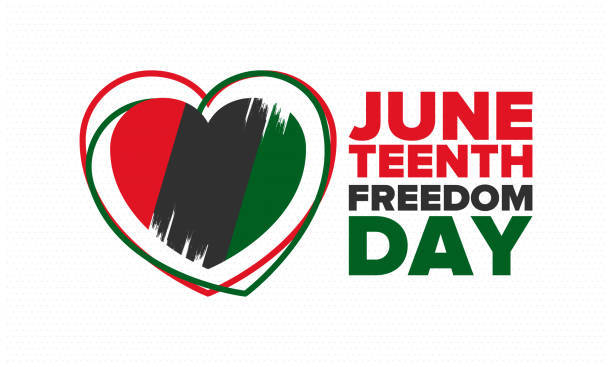Juneteenth
Sources: National Geographic, History.com, Juneteenth.com, Wikipedia
The United States has a new federal holiday. President Joe Biden signed a bill into law on June 17, 2021, the Juneteenth National Independence Day Act, that officially designates Juneteenth—observed each year on June 19th —as an American holiday.
Juneteenth (short for “June Nineteenth”) marks the day when federal troops arrived in Galveston, Texas in 1865 to take control of the state and ensure that all enslaved people be freed. The troops’ arrival came a full two and a half years after the signing of the Emancipation Proclamation. Juneteenth honors the end to slavery in the United States and is considered the longest-running African American holiday.
Juneteenth has gained awareness in recent years as activists have pushed for state and federal recognition. With the signing of this bill, those efforts will finally come to fruition as Juneteenth becomes the first new federal holiday since the establishment of Martin Luther King Jr. Day in 1983.
What’s The Backstory? Freedom after the Confederacy
At the stroke of midnight on January 1st, 1863, the Emancipation Proclamation came into effect and declared enslaved people in the Confederacy free—on the condition that the Union won the war. The proclamation turned the war into a fight for freedom and by The Emancipation Proclamation issued by President Abraham Lincoln on January 1, 1863, had established that all enslaved people in Confederate states in rebellion against the Union “shall be then, thenceforward, and forever free.”
But in reality, the Emancipation Proclamation didn’t instantly free any enslaved people. The proclamation only applied to places under Confederate control and not to slave-holding Border States or rebel areas already under Union control. However, as Northern troops advanced into the Confederate South, many enslaved people fled behind Union lines.
In the context of the American Civil War (1861–65), the Border States that were slave states that did not secede from the Union were Delaware, Maryland, Kentucky, and Missouri, and after 1863, the new state of West Virginia.
The economy of slavery wasn’t relegated to the South: it crossed state lines, and even states with low slaveholding populations were profiting from the labor of the enslaved. From tobacco cultivation in Virginia to shipbuilding in Rhode Island, industries throughout the states both supported, and were supported by, slavery. By 1850, 80% of American exports were the product of slave labor. The estimated value of enslaved people increased 500% between 1790 and 1860, from $200 million to around $3.059 billion. Slavery’s profitability far outweighed the moral outrage it engendered.
Juneteenth and Slavery in Texas
In Texas, slavery had continued as the state experienced no large-scale fighting or significant presence of Union troops. Many enslavers from outside the Lone Star State had moved there, as they viewed it as a safe haven for slavery.
Since Texas was one of the last strongholds of the South, emancipation would be a long-time coming for enslaved people in the state. Even after the last battle of the Civil War was fought in 1865—a full two years after the Emancipation Proclamation was signed—it is believed that many enslaved people still did not know they were free. As the story goes, some 250,000 enslaved people only learned of their freedom after Union General Gordon Granger arrived in Galveston, Texas, on June 19th, 1865, and announced that the president had issued a proclamation freeing them.
On that day, Granger declared, “The people of Texas are informed that, in accordance with a proclamation from the Executive of the United States, all slaves are free. This involves an absolute equality of personal rights and rights of property between former masters and slaves, and the connection heretofore existing between them becomes that between employer and hired labor.”
A Celebratory Day
With Granger’s announcement, June 19th—which would eventually come to be known as Juneteenth—became a day to celebrate the end of slavery in Texas. As newly freed Texans began moving to neighboring states, Juneteenth celebrations spread across the South and beyond.
The year following 1865, freedmen in Texas organized the first of what became the annual celebration of “Jubilee Day” on June 19th. In the ensuing decades, Juneteenth commemorations featured music, barbecues, prayer services and other activities, and as Black people migrated from Texas to other parts of the country the Juneteenth tradition spread.
In 1979, Texas became the first state to make Juneteenth an official holiday; several others followed suit over the years. In June 2021, Congress passed a resolution establishing Juneteenth as a national holiday; President Biden signed it into law on June 17, 2021.
For decades, many southern Black communities were forced to celebrate Juneteenth on the outskirts of town due to racism and Jim Crow laws. To ensure they had a safe place to gather for church services, public readings of the Emancipation Proclamation, and social events like rodeos and dances, Juneteenth groups would often collectively purchase plots of land in the city on which to celebrate. These parks were commonly named Emancipation Parks, many of which still exist today.
As the Civil Rights movement gained momentum in the ‘60s, Juneteenth celebrations faded. In recent years, however, Juneteenth has regained popularity and is often celebrated with food and community. It also has helped raise awareness about ongoing issues facing the African-American community, including a political fight for reparations, or compensation, to the descendants of victims of slavery.
Other emancipation celebrations
Despite the holiday’s resurgence in popularity, Juneteenth is still not universally known and is often confused with Emancipation Day, which is annually celebrated on April 16.
Just as Juneteenth originally celebrated freedom in Texas, Emancipation Day specifically marks the day when President Lincoln freed some 3,000 enslaved people in Washington, D.C.—a full eight months before the Emancipation Proclamation and nearly three years before those in Texas would be freed.

